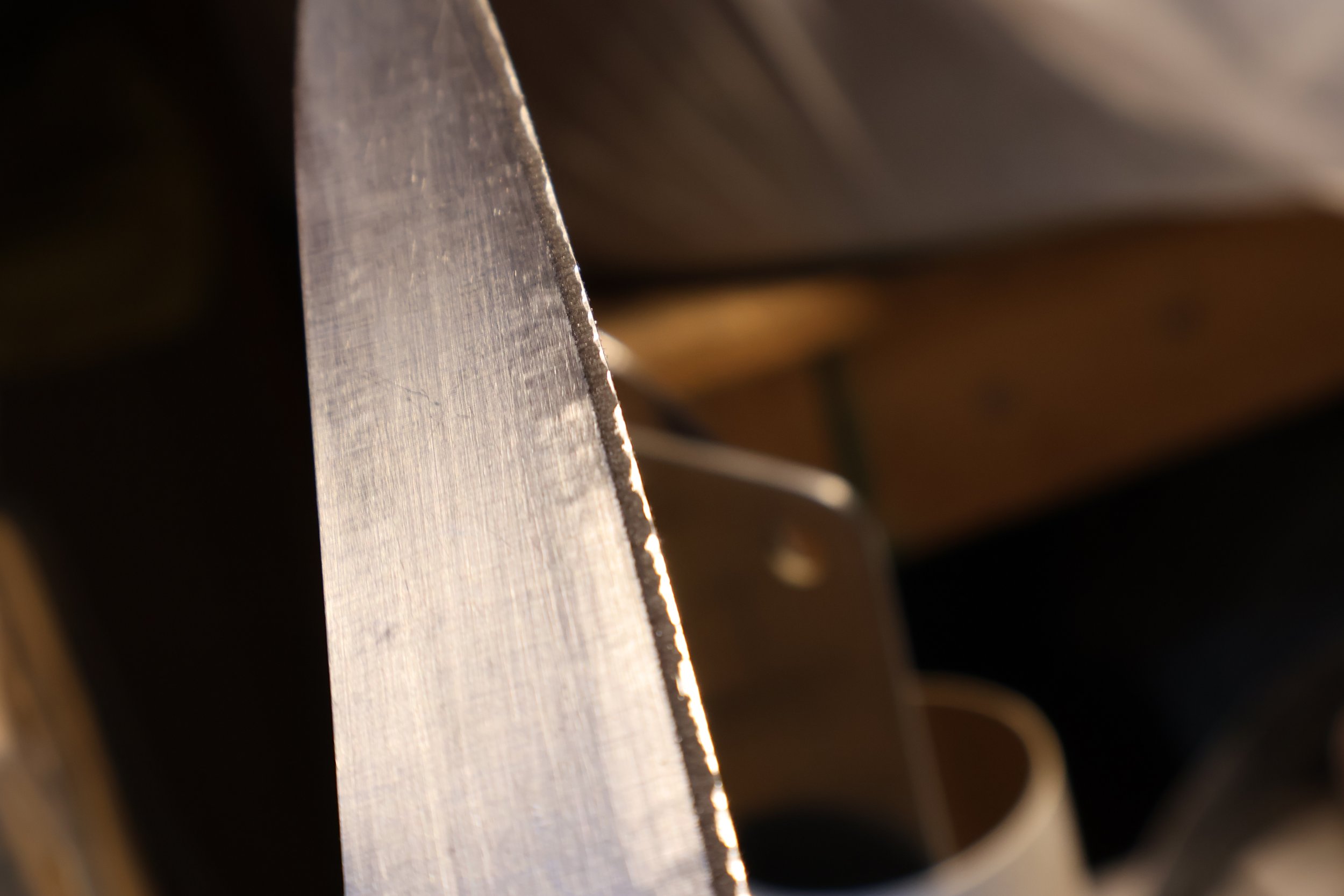ThE DAMAGE.
This picture is a close up of an knife that was consistently pulled through a manual pull-through knife sharpener.
This picture is a close up of the same knife that was repaired by us.
This picture is a knife that was brought to a local butcher shop to be sharpened for free. This was one out of SIX knife that came back with the same problem: a concave edge at the heel of the knife.
This knife came back from a local groccery store that offered free knife sharpening. They used an electric pull-through sharpener. You can visibly see the damage an electric pull-through sharpener does to a knife’s edge—it creates weak and brittle spots, visible as the shiny areas on the knife’s edge, along with micro-serrations instead of a smooth, refined edge. It also removes excessive metal, which over time leads to an uneven blade thickness. Some parts of the edge become too thin and fragile, making them more prone to chipping or rolling, while other areas remain thick and clunky, causing resistance during cutting. This imbalance not only affects the knife’s precision and ease of use but also makes future sharpening more difficult, eventually shortening the knife’s lifespan. Costing you money.
take away.
Ever noticed that butcher shops and grocery stores offer free knife sharpening? They all use electric pull-through sharpeners, and there’s a reason they don’t charge—it keeps you coming back. The faster your knife dulls, the more often you return to their store, increasing your chances of making a purchase. You actually spend more money in the long term using this free service. Not only will you spend more time and money in the groccery store — you spend more money buying kitchen knives. Free isn’t really free. You are just paying it in other ways.
While it might seem like a good deal, these quick-fix sharpeners are shortening the life of your knives.
The Edge Matters.
This is a magnified (1000x) close up of an knife’s edge. This particular knife was pulled through an electric pull-through knife sharpener.
This is a magnified (1000x) close up of an knife’s edge that was sharpened by us.
This picture is a close up of an knife that was pulled through an electric pull-through knife sharpener.
This picture is a close up of an knife that was sharpened by us.
take away.
Not all sharpening methods are equal. The edge of the knife is crucial—it determines how well your knife performs. A properly honed and polished edge stays sharp longer, making cutting effortless and precise. On the flip side, a poorly maintained edge—especially one damaged by pull-through sharpeners—dulls quickly and forces you to replace knives more often. Investing time in proper sharpening preserves the edge, saves you money, and enhances your cooking experience.
The sharpness of the edge ensures cleaner cuts, less damage to delicate ingredients, and more visually appealing dishes.
The edge of the knife isn't just about efficiency; it's about safety too. Dull edges require more force, increasing the risk of slips and accidents. A sharp edge offers better control, reducing strain on your hands and wrists. By focusing on maintaining the edge properly, you're not only extending the lifespan of your knives but also making your kitchen safer.
The Technique Matters.
This video shows how well a cheap pull-through knife sharpener from Amazon works. The knife used in this video, and the next one, came from Dollar Tree. A highly scientific cardboard cutting test was performed. The knife managed 14 cuts before it started to struggle. It also failed the paper test.
This time, the knife was sharpened by us. The difference is obvious compared to the last video. The knife sliced through 5x more cardboard AND aced the paper test, no problem.
The Sharp Difference.
Using a pull-through sharpener can lead to negative consequences for your blades. These sharpeners often create uneven edges, which can result in decreased cutting efficiency and increased wear on the blade over time. The aggressive nature of their design can also lead to excessive material removal, shortening the lifespan of your knives-costing you more money in the long run. Additionally, the harsh grinding action can cause micro-chipping along the edge, especially on harder steel blades, making them more prone to damage. In the long run, reliance on these tools can cause frustration and ultimately necessitate professional sharpening services to restore your blades to their optimal condition.







